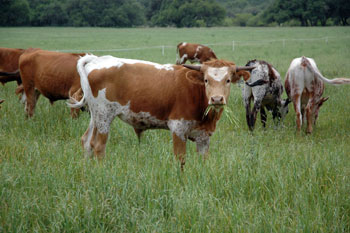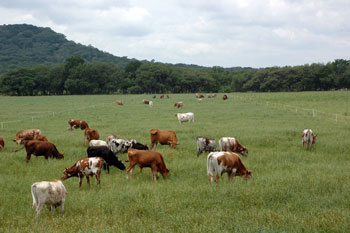 Why Grassfed?
Why Grassfed?
Animals grazed on pasture possess naturally occurring antioxidants in their muscles. Those healthy nutrients are lost when animals are fed grain and replaced with carcinogenic acids. Higher concentrations of Vitamins A and E and Keratin are present in grassfed meats than meat from animals fed starchy grains. Herbivores evolved to consume forage in its natural environment. Confining herding animals into crowded feedlots is unnatural. Animals, like humans, under continuous stressful situations develop health problems. The rumen (stomach) of cattle is not designed to digest large quantities of starchy grain. Feeding grains changes the pH and micro-flora in the rumen. Higher acid levels cause liver abscess and other digestive upsets that then require antibiotic treatment for the animal to continue eating and gaining weight. A high percentage of administered antibiotics are not broken down in the body of an animal so they are excreted. Pathogens come into contact with these low levels of antibiotics in overcrowded conditions of feedlots and develop resistance to the very formulations that were designed to combat them. This has caused need for stronger antibiotics to be developed to combat the same pathogens that have filtered over into human medicine as well. (Article) Constant hoof action in feedlots prevents any forage from being able to grow. Rainfall runs off taking with it high concentrations of Nitrogen that finds its way into our water systems, causing algae blooms that remove oxygen from the water, which can be deadly to aquatic life. Manure and urine are deposited in high concentration on bare ground forcing feedlot confined animals to breath ammonia. Dust from these substances is heavy in the air of feedlots causing respiratory distress in the animals. Parasites and flies become a problem that must be treated with chemical antihelmenthics and insecticides. The natural world takes care of those issues on pastureland. Dung beetles carry away manure and deposit it in holes they dig into the soil. In turn, the manure becomes fertilizer to grow more grass. Grassfed production systems utilize the most nutritious tops of forage, and then the animals are moved to fresh pasture so the grass plants are allowed to regrow. This rotation of pasture breaks the life cycle of parasites, so animals are not infested. Rain that falls on pastureland is absorbed into the soil and channeled by plant roots back into the ground water table. The healthiest meats, dairy and eggs come from pastured animals within a 200-mile radius of the consumer.
 Why local?
Why local?
Less fossil fuel is
used in transporting animals and meat, and shorter transport time is more
humane for the animals. Buying local supports our local economy.
Grassfed production systems are sustainable and environmentally sound.
Vote with your dollars for what you want to exist in your world. When it
comes to produce, local is more nutritious. Vine-ripened fruit and
vegetables are higher in brix (natural sugars from which your body draws nutrients),
than produce picked green and shipped hundreds, even thousands of miles.
Is there a difference in quality of local vs. imported foods labeled
"grassfed" and "Organic?" You be the judge http://www.thegreenmama.com/blog/organic-and-china-oxymoron,
http://www.alternet.org/story/60670/ US Organic production standards are
strictly enforced within our borders. Our grassfed beef is available for
sale to individuals wishing to purchase in bulk http://www.banderagrassland.com/retail.html. For more in-depth information about the benefits of grassfed, visit the websites of: http://www.eatwild.com/, http://www.westonaprice.org/,
& http://www.americangrassfed.org/